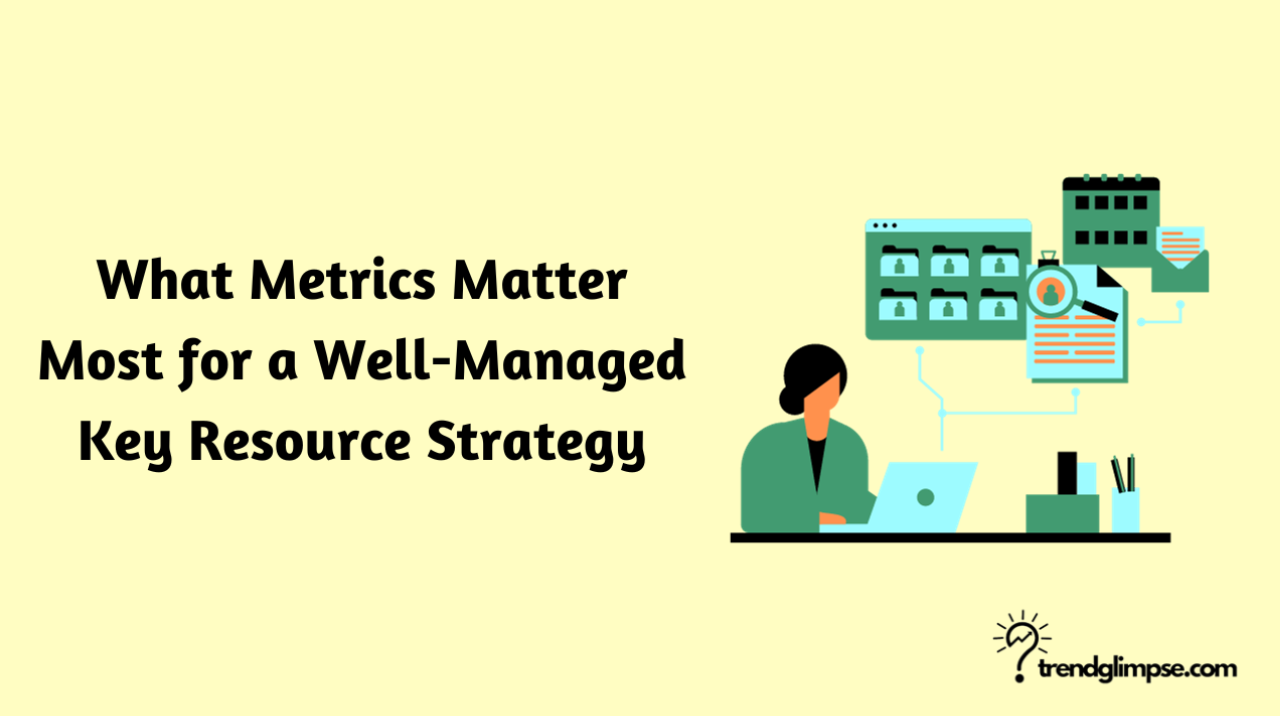Introduction
When it comes to managing your company’s key resources, having the right metrics in place is crucial. But with so many options to choose from, how do you know which ones actually matter?
In this post, we’ll break down the top three metrics that provide the most value for keeping tabs on your key resource strategy. We’ll look at capacity utilization, asset turnover ratio, and maintenance expense as percent of asset value. Monitoring these big three will help ensure your resources align to business objectives and enable growth.
Employee Metrics
Employee Satisfaction
Employee engagement scores
When it comes to managing your key resources – your employees – there are a few key metrics that matter most. First, keep a close eye on employee engagement scores. These provide insight into how connected, loyal and motivated your people feel. Low engagement scores can be an early warning of turnover or performance problems ahead. Leading companies like Microsoft, Intel and Apple regularly survey engagement and respond quickly if scores dip.
Employee turnover rate
Another vital metric is employee turnover rate. Some turnover is healthy, but excessive churn will destroy productivity. Set goals by department and job type, track turnover monthly and diagnose the reasons people leave. Are better recruitment, compensation or management interventions needed? Shopify worked hard to keep turnover under control as it grew from 700 to over 10,000 employees.
Exit interview feedback
Also analyze exit interview feedback systematically. Listen carefully to understand why high performers leave and whether any themes point to fixable issues. Does feedback suggest poor leadership, lack of development opportunities or pay inequities? Wise managers address these quickly. Netflix is legendary for how carefully they analyze and act upon exit interview learnings.
Employee Productivity
Revenue per employee
Let’s start with revenue per employee. This metric calculates total company revenue divided by the number of employees. It establishes a clear benchmark for the average sales and business generated per staff member. Salesforce, a prominent CRM company, boasted impressive revenue per employee numbers – over $350k annually per staffer. Tracking this over time allows you to set goals around scaling production as you add staff.
Profit per employee
Next is profit per employee, an insightful productivity indicator calculated by dividing total profit by total employees. Consumer goods giant P&G has historically high PPE numbers, reaching over $27,000 profit annually per employee. High and rising PPE signals that your existing staff is effectively converting sales into bottom-line returns without excess overhead dragging down margins.
Output per employee
The last key metric is output per employee. This measures total output volume generated relative to current staffing levels. Manufacturers can track units produced per factory worker, whereas service teams can analyze client cases managed per service rep. Output per employee ensures departments aren’t over or understaffed relative to workload. Well-resourced teams demonstrate higher output levels per staff member.
Customer Metrics
Customer Satisfaction
Net Promoter Score (NPS)
The Net Promoter Score (NPS) indicates customer loyalty by asking “How likely are you to recommend us to a friend or colleague?” Scores range from -100 to 100, with higher being better. Successful companies like Apple and Amazon aim for NPS over 50. Check your NPS frequently via surveys and strive to understand what matters most to customers through their verbatim feedback.
Customer satisfaction (CSAT) scores
Customer satisfaction (CSAT) measures overall post-purchase happiness by asking “How satisfied were you with your experience?” Scores are 0-10 or 0-100. Leading brands target over 90 points. Survey customers after interactions to get timely, specific CSAT data. Review feedback, identify pain points, and continually refine operations to exceed customer expectations, thereby improving satisfaction over time.
Repeat customer rate
The repeat customer rate shows customer retention by reporting the percentage of customers that return for additional purchases. Subscription services like Dollar Shave Club thrive on rates over 50%. Calculate repeat rate monthly, strive for year-over-year increases through loyalty programs and enhancing the customer experience. Analyze why customers return and double-down on those areas through investment and innovation.
Referral rate
The referral rate shows how often existing customers recommend you to others. Ask happy customers for referrals during onboarding, after good support calls, through email surveys, etc. Make sharing easy on social media. Reward advocates with discounts for spreading the word. Analyze spikes when new products/features launch to double down on what resonates.
Customer Engagement
Website traffic
A key metric is website traffic, specifically knowing where visitors originate can inform resource allocation. Successful companies track traffic sources to understand the high-ROI areas to invest in, whether SEO, paid ads, referral programs, etc. Measure month-over-month and set traffic growth goals, using tools like Google Analytics. Concentrate efforts on expanding your best channels.
Bounce rate
An important complement to traffic is bounce rate – the percentage exiting quickly. A high bounce rate signals suboptimal landing pages. Leading firms rigorously A/B test landing pages to optimize conversion. Experiment with copy, visuals, and calls-to-action. Define an acceptable target bounce rate for each landing page group. Continually evolve pages to keep visitors engaged.
Time on site
The time visitors actively spend on your site reveals engagement and value. Set time-on-site goals by page. Use heatmaps to understand popular click flows and identify areas losing traffic. Companies succeeding at engagement curate content for differentiated audience segments and personalize site experiences. Set and monitor target session times as KPIs, investigate declines, and keep improving stickiness. The longer visitors stay, the deeper the relationship.
Conversion rate
The website conversion rate, or percentage of visitors completing desired actions, spotlights how compellingly you motivate visitors. Sophisticated companies map the entire conversion funnel to set optimization priorities. Implement clear calls-to-action, provide sufficient product/service information, highlight customer proof-points through reviews or testimonials, make signing up easy, and keep testing and evolving.
Operational Metrics
Utilization Rate
Asset utilization percentage
When it comes to managing your key resources – whether that’s assets, people, or intellectual property – having the right metrics in place is crucial. One of the most important is utilization rate. This measures how much your resources are actually being used versus sitting idle. For assets like equipment and machinery, you want to track asset utilization percentage. This calculates the amount of time they are actively running jobs compared to downtime or maintenance. Leading manufacturing companies like Toyota aim for 95-100% utilization to maximize productivity.
Labor utilization percentage
Similarly, if your key resource is staff with specialized skills, labor utilization rates are vital. This quantifies the percentage of total work hours where they are actively engaged versus administrative tasks or empty time. Consultancies like McKinsey aim for 75-90% utilization across teams. The key is aligning utilization to strategy – an expert researcher creating innovative algorithms requires deep thinking time, while customer service reps need to maximize time answering calls.
Efficiency Metrics
Order lead time
Amazon obsessively tracks order lead time and aims to constantly reduce it. The faster Amazon can get a product from its warehouse shelves into the hands of customers after they click buy, the more loyal and satisfied those customers become. Through process improvements, technology investments, and logistics innovations, Amazon has cut order lead times from days or weeks to just hours or minutes for a growing number of products.
Supply chain velocity
Companies like McDonald’s monitor supply chain velocity – the speed at which ingredients and supplies move through their distribution channels. By keeping tight control of supply chain velocity, McDonald’s ensures popular menu items are constantly in stock at its restaurants around the world. Supply shortages translate to lost sales and dissatisfied customers.
First call resolution rate
Metrics like first call resolution rate also matter. Leading call centers recognize that resolving customer inquiries the first time they call saves significant money on overhead while also improving customer satisfaction. Companies invest in employee training, knowledge management systems, and other tools to enable first call resolution as much as possible.
Conclusion
At the end of the day, having the right key resource metrics in place is crucial for executing a sound business strategy. Tracking utilization rates, capacity planning, investment effectiveness, and risk exposure provides invaluable insights. While it may seem tedious, taking the time to identify and consistently monitor the metrics that track your most vital assets pays dividends.
With clear visibility into the performance and health of your key resources, you empower your leaders to make data-driven decisions that optimize growth, improve agility to market changes, and ultimately drive better business outcomes. What metrics will you start tracking this quarter?

I have always been fascinated by the inner workings of companies and industries. So I decided to study business to explore it more. My goal is to take all my research and turn it into cool stories that give people a better understanding of the business world.

